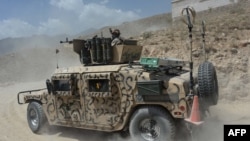Spotlight On Iran
Can IS Be Stopped in Afghanistan?

The Islamic State (IS) group is rapidly expanding in parts of Afghanistan, advancing militarily into areas where it once had a weak presence and strengthening its forces in core regions, according to Afghan and U.S. officials.
Depending on the location, the proliferation of IS has drawn varied resistance from the Afghan military, U.S. air support and ground troops, local militias, Taliban forces and other militant groups.
Attacking IS has become such a priority in the country, that disparate forces sometimes join together in the ad-hoc fight, with Afghan and U.S. forces finding themselves inadvertently supporting the enemy Taliban in battling IS.
Confusion
All too often, officials say, mistakes are made due to confusion on the ground.
Afghan army planes on Wednesday night accidentally air dropped vital supplies of food and water to IS militants in the Darzab district of northern Jouzjan province instead of to their own besieged troops, provincial police chief, Rahmatullah Turkistani told VOA. The supplies were meant to help Afghan forces that are countering twin attacks by IS and Taliban militants but were used instead by IS.
“It's not getting better in Afghanistan in terms of IS,” U.S. Chief Pentagon Spokeswoman Dana White told VOA this week. “We have a problem, and we have to defeat them and we have to be focused on that problem.”
Reinforcements for the IS cause reportedly are streaming into isolated areas of the country from far and wide. There are reports of fighters from varied nationalities joining the ranks, including militants from Pakistan, India, Iran, Iraq, Syria, Russia and Central Asian neighbors.
Still, the Islamic State-Khorasan (ISK), as IS is known in Afghanistan, remains a fragmented group composed of differing regional forces with different agendas in different parts of the country.
“IS-K is still conducting low-level recruiting and distribution of propaganda in various provinces across Afghanistan, but it does not have the ability or authority to conduct multiple operations across the country,” a recent Pentagon report said. But where it operates, IS is inflicting chaos and casualties and causing confusing scenarios for disparate opponents.
In the Tora Bora area, where IS has made a strong stand in recent days, local villagers and militias joined with Taliban to rout IS. IS regained ground after a few days, leading to U.S. military air attacks on IS positions in conjunction with Afghan intelligence instructions and army operations.
IS fighters reportedly have fled from mountain caves of Tora Bora, where al-Qaida's leader Osama bin Laden hid from U.S. attack in 2001.
Displaced Families
IS fighters were also reportedly advancing in neighboring Khogyani district, displacing hundreds of families, according to district officials. It is one of several areas in Nangarhar province, near the Pakistani border, where IS has been active for over two years.
Fierce clashes in the Chaparhar district of Nangarhar last month left 21 Taliban fighters and seven IS militants dead, according to a provincial spokesman. At least three civilians who were caught in the crossfire were killed and five others wounded.
“IS has overpowered Taliban in some parts of Nangarhar because the Taliban dispatched its elite commando force called Sara Qeta (Red Brigade) to other parts of the country, including some northern provinces to contain the growing influence of IS there,” Wahid Muzhda, a Taliban expert in Kabul, told VOA.
Recruiting Youth
IS has also expanded in neighboring Kunar province, where, according to provincial police chief, it has a presence in at least eight districts and runs a training base, where foreign members of IS, train new recruits.
Hundreds of miles from Nangarhar, IS is attempting to establish a persistent presence in several northern provinces where it has found a fertile ground for attracting militants and recruiting unemployed youths, mostly between the age of 13 and 20.
IS has been able to draw its members from the Pakistani Taliban fighters, former Afghan Taliban, and other militants who “believe that associating with or pledging allegiance” to IS will further their interests, according to the Pentagon report.
Hundreds of militants have joined IS ranks in northern Jouzjan and Sar-e-Pul province where local militant commanders lead IS-affiliate groups in several districts.
Darzab District
Qari Hekmat, an ethnic Uzbek and former Taliban militant who joined IS a year ago, claims to have up to 500 members, including around 50 Uzbek nationals who are affiliated with the Islamic Movement of Uzbekistan (IMU) — previously associated with al-Qaida and Taliban in Afghanistan.
IS and Taliban are reportedly fighting over the control of Darzab district in Jouzjan which they stormed this week from two different directions and besieged scores of government forces. The Taliban has reportedly captured the center of the district while IS militants control the city outskirts.
Afghanistan faces a continuing threat from as many as 20 insurgent and terrorist networks present or operating in the Afghanistan-Pakistan region, including IS, the Pentagon said.
“In areas where the government has limited influence and control, IS attempts to emerge and expand there,” Ateequllah Amarkhail, an analysts and former Army general in Kabul told VOA.
Strategy
IS has also claimed responsibility for several recent attacks in urban areas, however, with a hit-and-hide strategy that is proving effective. And it is engaging too in more skirmishes with U.S. forces that initially were sent to the country to help Afghan forces halt the spread of Taliban.
Three American service members based in eastern Afghanistan were killed in April during operations targeting IS militants, according to the Pentagon.
"ISIS-K remains a threat to Afghan and regional security, a threat to U.S. and coalition forces, and it retains the ability to conduct high-profile attacks in urban centers,” the Pentagon said.
-- Written by Noor Zahid for Voice Of America
See all News Updates of the Day




